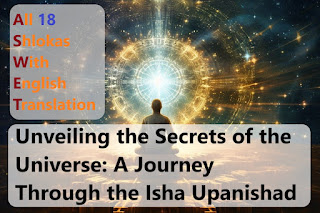Evolution | Evolution of Life on Earth | Evolution of Life | Evolution of Life Forms | Vedanta | Brihadaranyaka Upanishad Shlok 1.2.5 Part 2
 |
| Evolution of Life on Earth | Brihadaranyaka Upanishad Shlok 1.2.5 Part 2 |
#Hindi Watch https://youtu.be/Shyy_7dUnw4
#Bangla Watch https://youtu.be/klpGAWW7rQA
Welcome back to our blog! Today, we continue with the interpretation of the fifth shloka of the second Brahmana in the first chapter of the Brihadaranyaka Upanishad. In this article, we will explore the evolution of life in detail.
Before we start part 2, I recommend reading our previous articles covering “How Life Began on Earth?”, the formation of the universe, the formation of the solar system, meditation on Viraj, the origin of the universe, and our introduction to the Brihadaranyaka Upanishad. We also have a series of articles on the Isha Upanishad, which unveils the Secrets of the Self. You can find links to these articles at the bottom of the page.
In our last article, I mentioned that in this shloka, the Rishi addresses a fundamental question: “How did life begin on this planet?” The Rishi explains that Hiranyagarbha created a variety of species, including humans and animals, as part of a divine plan. But this creation did not happen in an instant. After life originated on Earth around 3.5 to 4 billion years ago, it went through a long process called evolution, leading to today’s biodiversity.
2. Evolution of Life - Let’s now journey from the early RNA molecules to modern humans through the complex process of evolution, which involves mechanisms like natural selection, mutation, genetic drift, and gene flow.
Natural Selection: Organisms with traits better suited to their environment tend to survive and reproduce, passing on those traits. For instance, bacteria exposed to antibiotics mostly perish, but those with mutations that grant resistance survive. Over time, this leads to a population of antibiotic-resistant bacteria, such as Staphylococcus aureus (including MRSA), which poses challenges in healthcare.
Mutation: Mutations introduce new traits, some of which may be beneficial and become more common over generations. For example, a mutation in the LCT gene allows adults to digest lactose, the sugar in milk—a trait known as lactose tolerance.
Genetic Drift: In small populations, random changes in allele frequencies can significantly impact evolution. A well-known example is the cheetah, which experienced a genetic bottleneck around 10,000 years ago, resulting in low genetic diversity that makes the species more vulnerable to disease and environmental changes.
Gene Flow: Gene flow involves the transfer of genetic material between populations, increasing genetic diversity. For instance, when European settlers arrived in the Americas, gene flow with Indigenous populations resulted in a gene pool reflecting the ancestry of both groups.
Let us see the evolution of life on a timeline for last billion of years.
3.5 to 4 billion years ago: Life began with self-replicating molecules like RNA, which evolved into simple, single-celled organisms resembling modern prokaryotes.
2.5 to 3 billion years ago: Some prokaryotes developed the ability to perform photosynthesis.
2.4 billion years ago: Oxygen produced by photosynthetic bacteria accumulated, causing the Great Oxygenation Event, which enabled aerobic organisms to evolve.
1.8 to 2 billion years ago: Complex eukaryotic cells with a nucleus and organelles, such as mitochondria, emerged.
1 to 1.5 billion years ago: Multicellular organisms evolved, allowing for specialization of cells into tissues and organs.
540 million years ago: The Cambrian Explosion saw rapid diversification, leading to complex body plans in ancestors of modern animal phyla.
500 to 400 million years ago: Life began to colonize land, with plants, fungi, and arthropods appearing first.
375 million years ago: Vertebrates moved onto land, eventually evolving into amphibians, reptiles, birds, and mammals.
250 million years ago: After the Permian-Triassic extinction, reptiles dominated, though small mammals persisted.
65 million years ago: An asteroid impact led to the extinction of dinosaurs (except birds), allowing mammals to diversify.
50 to 60 million years ago: Primates, the group that includes humans, evolved from small, tree-dwelling mammals.
2 to 3 million years ago: The genus Homo emerged, eventually leading to modern humans who developed tools, language, and spread globally.
Today, life on Earth is incredibly diverse, with evolution continuing to shape species and ecosystems.
In part 3 we will delve into Evolution of Human Civilization.
Thank you for joining us in this journey of Universal Vedanta. Don't forget to share this post and YouTube video, like, and subscribe to our YouTube channel - Universal Vedanta . Press the bell icon for notifications on new sessions. Share your thoughts and questions in the comments, and follow us on WhatsApp channel, Facebook Page, Facebook Group, Instagram and X. Have a great day, and see you in the next post!
Follow us on
Youtube: https://www.youtube.com/@universalvedanta
WhatsApp: https://whatsapp.com/channel/0029Va5D8cn5PO12m5EbE42y
Readers' List
how life began on earth | how life formed on earth | how life started | Origin of LIfe | Vedanta | Hindu Philosophy
https://universal-vedanta.blogspot.com/2024/08/how-universe-was-created-according-to-hinduism-the-power-of-speaking.html
https://universal-vedanta.blogspot.com/2024/07/the-formation-of-solar-system-nebular.html
https://universal-vedanta.blogspot.com/2024/06/learn-meditation-on-viraj-meditation-on.html
Origin of The Universe | What Was The Big Bang? | The Hindu Interpretation of Creation
https://universal-vedanta.blogspot.com/2024/05/origin-of-universe-what-was-big-bang.html
Brihadaranyaka Upanishad - 20 Minute Guided Meditation | Cosmic Meditation
https://universal-vedanta.blogspot.com/2024/04/20-minute-guided-meditation-cosmic.html
https://universal-vedanta.blogspot.com/2024/03/brihadaranyaka-upanishad-chapter-1-1st-brahmana-cosmic-meditation.html
https://universal-vedanta.blogspot.com/2024/02/the-universe-is-infinite-you-are-too.html
https://universal-vedanta.blogspot.com/2024/02/isha-upanishad-explained-in-english.html
https://universal-vedanta.blogspot.com/2023/02/isha-upanishad-shloka-8-english-does.html
https://universal-vedanta.blogspot.com/2023/01/isha-upanishad-shloka-07-english-reason.html
https://universal-vedanta.blogspot.com/2023/01/isha-upanishad-shloka-06-english-hate.html
https://universal-vedanta.blogspot.com/2022/12/isha-upanishad-shloka-05-english-know.html
Isha Upanishad - Shloka - 04
https://universal-vedanta.blogspot.com/2022/12/isha-upanishad-shloka-04-english.html
Isha Upanishad - Shloka - 03
https://universal-vedanta.blogspot.com/2022/11/isha-upanishad-shloka-03-how-to-stop-killing-self.html
Isha Upanishad - Shloka - 02
https://universal-vedanta.blogspot.com/2022/10/isha-upanishad-shloka-02-how-to-live-100-years.html
Isha Upanishad - Shloka - 01
https://universal-vedanta.blogspot.com/2022/09/universal-vedanta-rishyashish-isha-upanishad-verse-01.html
Introduction to Isha Upanishad
https://universal-vedanta.blogspot.com/2022/08/universal-vedanta-rishyashish-isha-upanishad.html


Comments
Post a Comment